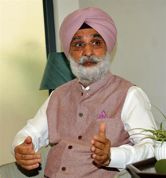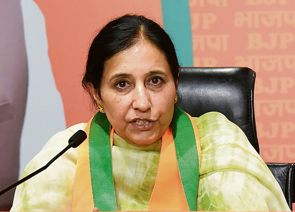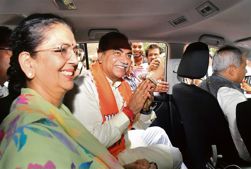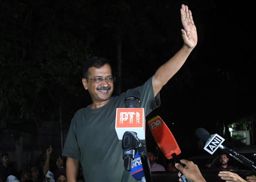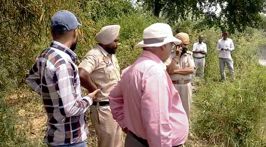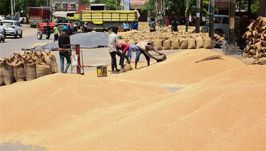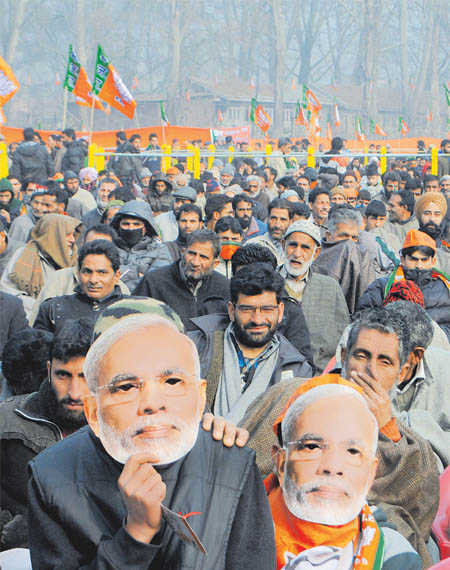
Supporters of the ruling Bharatiya Janata Party (BJP) wear a mask depicting the Prime Minister during Prime Minister Narendra Modi''s first election campaign rally in Srinagar at the Sher-i-Kashmir Cricket stadium. Tribune Photo: Amin War
Arun Joshi
Kashmir is a difficult and challenging terrain for any Prime Minister of the country. It builds personalities who seize opportunities and introduce appealing concepts of their respective brand of politics in a bold fashion— as did former Prime Minister Atal Behari Vajpayee who used the soil of Kashmir to extend a hand of friendship to Pakistan. It also is a graveyard of many a reputation — Manmohan Singh who started his innings with a commitment to build a "naya" or New Kashmir but ended with no grand results to show at the end of his decade-long tenure as Prime Minister.
Prime Minister Narendra Modi had more than one opportunity to transform the political, psychological and economic landscape of all the three regions of the state, particularly the Valley, in the past two years. His biggest strength is the massive electoral mandate and the personality cult. Despite a mood of trepidation in this only Muslim majority state of the country there was also a hope that he might chart a new course to give a real-time meaning to the three mantras of his illustrious predecessor Vajpayee who had envisioned a solution through insaniyat (humanity), jambhooriyat (democracy) and Kashmiriyat (a concept denoting the Valley’s composite culture) way back in 2000.
Modi reiterated his commitment to follow Vajpayee's path in 2014, 2015 and 2016 to reach out to the people of Kashmir, but the Valley is waiting for these pronouncements to be translated into action on the ground. The wait is getting longer as there are no visible steps being taken by New Delhi to know what is wrong and how it can be rectified.
Manmohan Singh pragmatically acknowledged the “internal and external dimensions” of the issue. His attempt was reflected in the five working groups that he had constituted to determine the extent of the problem at various fronts and to find out ways and means to address those. Simultaneously, he had opened channels of communication with Pakistan. As summed up by former Chief Minister Omar Abdullah in 2006, “There was a golden opportunity to resolve the K issue...” The internal situation in Pakistan in 2007, following the dismissal of Chief Justice Iftikhar Choudhary followed by 26/11 halted the process.
Prime Minister Modi's opening was stunningly remarkable. The South-Asian neighbourhood appeared on his foreign policy horizon. Pakistani Prime Minister Nawaz Sharif was among the leaders who attended Modi’s swearing-in ceremony. That was a grand gesture and there was a rethink in some quarters in Jammu and Kashmir about the image and attitude of Modi toward Pakistan and what all he wanted to achieve by this approach. A hope had sprung up for them.
A conspicuous part of Nawaz Sharif's visit to Delhi was that Hurriyat leaders from Kashmir were neither invited, nor did they insist on talks with the visiting Pakistan Prime Minister. Back home, Nawaz Sharif had to face a lot of flak for this miss. But some Hurriyat leaders sensed a chance of success of a process between two countries and were willing to wait for their turn to express their viewpoint. Mirwaiz Umar Farooq felt that if the two countries could make progress on their own, the Kashmir issue could be resolved with the involvement of leaders of Kashmir at some stage. He has been consistent in his belief that the process would lead to results and expectation of instant results could damage the process. Kashmir is a decades-old issue and it cannot be resolved overnight.
Notwithstanding the Prime Minister's endorsement of the PDP-BJP government in the state, the PDP-BJP government is stuck in its own contradictions. Its attempts to regain lost paradise are hobbled by the situation, scepticism and lack of adequate support on the ground. The PDP is unsure which side to tilt and the state's BJP leadership is clueless about Kashmir because they have never stepped out of their cocoons in Jammu. And, the result is that the common Kashmiri feels distanced and hemmed in by the one-sided narrative in which either the idea of composite culture or the idea of India is missing.
When Modi took over, there existed a breathing space for the idea of India in the Valley and forces of peace were visible. Radicalism had started appearing on the scene, but there were strong voices upholding the traditional values of Kashmir. The way he started visiting Jammu and Kashmir and unfolded the economic initiatives in the Railways, power and connectivity sectors, generated the hope of progress on the political front as well.
But doubts surfaced after the Foreign-Secretary level talk were called off, following a meeting of the Hurriyat leaders with Pakistan High Commissioner Abdul Basit in August, 2014. The fierce exchange of fire on borders, coupled with the rhetoric of the Assembly election campaign, despite the fact that there was no mention about the abrogation of Article 370 in the BJP's vision document, suspicion gained ground. The moment the BJP as a political party embarked on 44-plus mission Kashmir, the Muslims felt as if a tempest was about to hit their boat of identity. The BJP was more keen on securing a political victory than showcasing itself as Vajpayee's party, announcements to that effect notwithstanding.
In between, the Prime Minister had sounded a right note during the September 2014 floods, when he declared that the treasury of the Centre was open to provide relief to the marooned people in Jammu and Kashmir. But when things started moving at a snail's pace in response to the state government's plea for early release of the sum of money for the relief and rehabilitation, all those who stoked doubts had a field day. The announcement of Rs 80,000 crore in November 2015 could not succeed in damage control.
Today, the alienation in Kashmir is “more than 100 per cent,” quipped a young journalist in his twenties. This statement or perception is enough to disturb the sleep. Hordes of villagers thronging to disrupt the Army’s operations against militants and thousands attending the funeral of militants is a picture to which one cannot shut one's eyes. Two years have not made a difference the way people of Jammu and Kashmir were expecting. May be something really good happens in the third year.





















